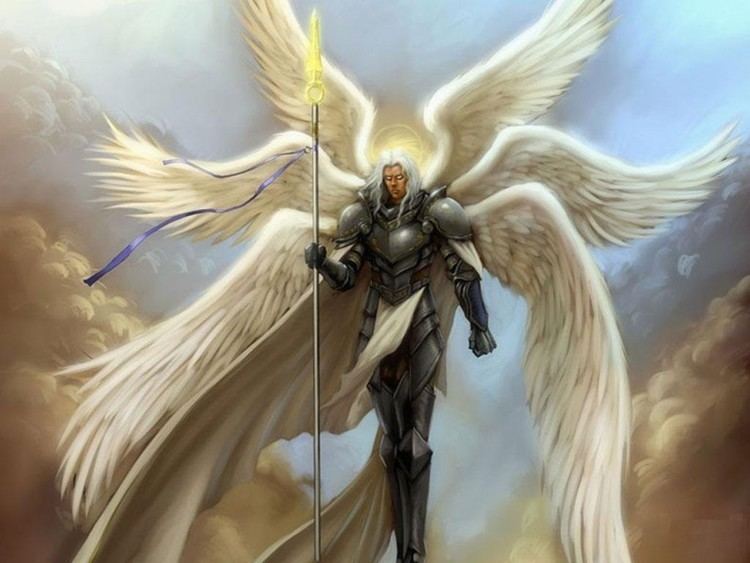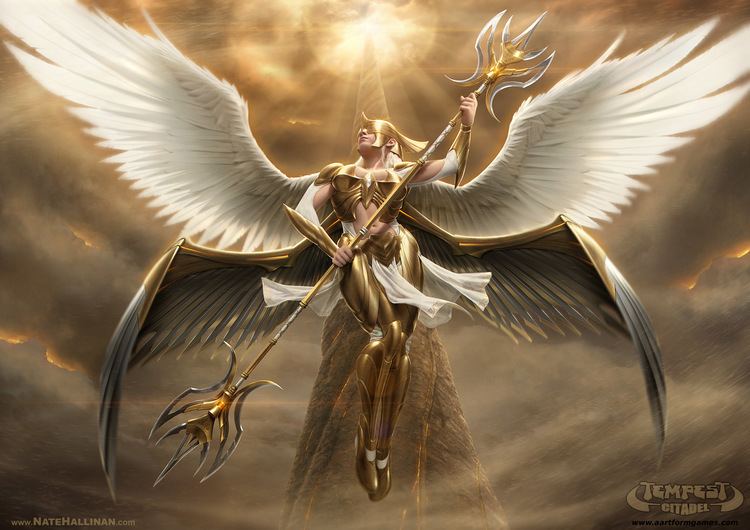Seraph action combat platformer
A seraph (/ˈsɛr.əf/, "the burning one"; pl. seraphs or seraphim /ˈsɛr.ə.fɪm/, in the King James Version also seraphims (plural); Hebrew: שָׂרָף śārāf, plural שְׂרָפִים śərāfîm; Latin: seraphim and seraphin (plural), also seraphus (-i, m.); Greek: σεραφείμ serapheím) is a type of celestial or heavenly being in Christianity and Judaism. The singular "seraph" is a back-formation from the plural "seraphim", whereas in Hebrew the singular is "saraph".
Contents
- Seraph action combat platformer
- Origins and development
- In Judaism
- In Christianity
- As mascots and symbols
- References

Tradition places seraphim in the highest rank in the Christian angelic hierarchy and in the fifth rank of ten in the Jewish angelic hierarchy. A seminal passage in the Book of Isaiah (Isaiah 6:1-8) used the term to describe six-winged beings that fly around the Throne of God crying "holy, holy, holy". This throne scene, with its triple invocation of holiness (a formula that came to be known as the Trisagion), profoundly influenced subsequent theology, literature and art. Its influence is frequently seen in works depicting angels, heaven and apotheosis. Seraphim are mentioned as celestial beings in an influential Hellenistic work, the Book of Enoch, and the Book of Revelation.

Origins and development
The word saraph/seraphim appears three times in the Torah (Numbers 21:6–8, Deuteronomy 8:15) and four times in the Book of Isaiah (6:2–6, 14:29, 30:6). In Isaiah 6:2-6 the term is used to describe a type of celestial being or angel. The other five uses of the word refer to serpents.
The vision in Isaiah Chapter 6 of seraphim in an idealised Jerusalem First Temple represents the sole instance in the Hebrew Bible of this word being used to describe celestial beings. "... I saw the Lord sitting upon a throne, high and lifted up; and His train filled the Hekhal (sanctuary). Above him stood the Seraphim; each had six wings; with two he covered his face, and with two he covered his feet, and with two he flew." (Isaiah 6:1–3) The seraphim cry continually to each other, "Holy, holy, holy, is YHWH of hosts: the whole earth is full of His glory." (verses 2–3) One seraph then carries out an act of purification for the prophet by touching his lips with a live coal from the altar (verses 6–7). The text literally describes the "seraphim" as winged celestial beings with a fiery passion for doing God's good work. Notwithstanding the wording of the text itself, at least one Hebrew scholar claims that in the Hebrew Bible the seraphim do not have the status of angels, and that it is only in later sources (like De Coelesti Hierarchia or Summa Theologiae that they are considered to be a division of the divine messengers.
Seraphim appear in the 2nd-century BC Book of Enoch where they are mentioned, in conjunction with cherubim, as the heavenly creatures standing nearest to the throne of God. They are also called the Ikisat (Ethiopic: አክይስት — "serpents", "dragons"; an alternate term for Hell) which, along with the cherubim and Paradise, are under the rule of Gabriel. In the Second Book of Enoch, two classes of celestial beings are equated with the seraphim and cherubim, known as the phoenixes and the chalkydri (from Gr. χαλκύδραι, compd. of χαλκός "brass", "copper" + ύδρα "hydra", "water-serpent" — lit. "brazen hydras", "copper serpents"). Both are described as "flying elements of the sun" that reside in either the 4th or 6th heaven, who have twelve wings and burst into song at sunrise.
In the Book of Revelation (iv. 4–8) the seraphim are described as being forever in God's presence and praising him: "Day and night with out ceasing they sing: 'Holy, holy, holy is the Lord God Almighty, who was and is and is to come.'" However this account differs slightly from the account of Isaiah, stating in the eighth verse, "Each of the four living creatures had six wings and was covered with eyes all around, even under his wings." They appear also in the Christian Gnostic text On the Origin of the World.
In Judaism
The 12th-century scholar Maimonides placed the seraphim in the fifth of ten ranks of angels in his exposition of the Jewish angelic hierarchy. In Kabbalah, the seraphim are the higher angels of the World of Beriah ("Creation", first created realm, divine understanding), whose understanding of their distance from the absolute divinity of Atziluth causes their continual "burning up" in self-nullification. Through this they ascend to God, and return to their place. Below them in the World of Yetzirah ("Formation", archetypal creation, divine emotions) are the Hayot angels of Ezekiel's vision, who serve God with self-aware instinctive emotions ("face of a lion, ox, eagle"). Seraphim are part of the angelarchy of modern Orthodox Judaism. Isaiah's vision is repeated several times in daily Jewish services, including at Kedushah prayer as part of the repetition of the Amidah, and in several other prayers as well. Conservative Judaism retains the traditional doctrines regarding angels and includes references to them in the liturgy, although a literal belief in angels is by no means universal among adherents. Adherents of Reform Judaism and Reconstructionist Judaism generally take images of angels as symbolic.
An ancient Judean seal from the 8th century BC depicts them as flying asps, yet having human characteristics, as encountered by Isaiah in his commissioning as a prophet.
In Christianity
Medieval Christian theology places seraphim in the highest choir of the angelic hierarchy. They are the caretakers of God's throne, continuously singing "holy, holy, holy". Pseudo-Dionysius the Areopagite in his Celestial Hierarchy (vii), drew upon the Book of Isaiah in fixing the fiery nature of seraphim in the medieval imagination. Seraphim in his view helped the Deity maintain perfect order and are not limited to chanting the trisagion. Taking his cue as well from writings in the Rabbinic tradition, the author gave an etymology for the Seraphim as "those who kindle or make hot":
The name seraphim clearly indicates their ceaseless and eternal revolution about Divine Principles, their heat and keenness, the exuberance of their intense, perpetual, tireless activity, and their elevative and energetic assimilation of those below, kindling them and firing them to their own heat, and wholly purifying them by a burning and all-consuming flame; and by the unhidden, unquenchable, changeless, radiant and enlightening power, dispelling and destroying the shadows of darkness
Thomas Aquinas in his Summa Theologiae offers a description of the nature of seraphim:
The seraphim took on a mystic role in Pico della Mirandola's Oration on the Dignity of Man (1487), the epitome of Renaissance humanism. Pico took the fiery Seraphim—"they burn with the fire of charity"—as the highest models of human aspiration: "impatient of any second place, let us emulate dignity and glory. And, if we will it, we shall be inferior to them in nothing", the young Pico announced, in the first flush of optimistic confidence in the human capacity that is the coinage of the Renaissance. "In the light of intelligence, meditating upon the Creator in His work, and the work in its Creator, we shall be resplendent with the light of the Cherubim. If we burn with love for the Creator only, his consuming fire will quickly transform us into the flaming likeness of the Seraphim."
St. Bonaventure, a Franciscan theologian who was a contemporary of Aquinas, uses the six wings of the seraph as an important analogical construct in his mystical work The Journey of the Mind to God.
Christian theology developed an idea of seraphim as beings of pure light who enjoy direct communication with God.
As mascots and symbols
Several Catholic schools use a Seraph or a seraph-related symbol as their mascot:
In addition, Kingswood College in Randles Hill, Kandy, Sri Lanka, a public school, claims the seraph as its mascot.
Several Rolls-Royce models use a "Flying Lady" symbol or moniker, which some equate to a seraph.
